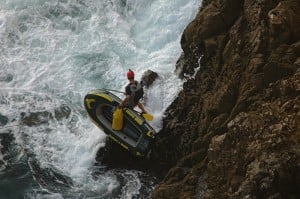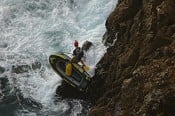

Chris Mellor is making available all these PDFs of his Sea Stack climbing guide to the UK freely as a service to UKClimbing users and anyone else. He retains the copyright in them (so you can't pretend they're yours) but you can redistribute them as you wish, but NOT sell them.
A stack is an isolated pinnacle of rock entirely surrounded by the sea at high tide. The term comes, I think, from an old Norse (Viking) word - stac - meaning a steep rock or conical hill. It is still used in Scottish Gaelic with places such as Stac Pollaidh which is a very conical inland peak.
A stack is not an island. How can you tell the difference? A rough and ready definition is: if its top is further across than the height then it is an island - or a low rock. I think a stack should be at least 30 feet high. Below that it is a rock. A stack need not be a perpendicular tower. Blackchurch Rock is a stack even though its main face is a triangular-shaped slab. However a stack should be rocky on all sides and involve scrambling at the very least to get to the top. Gannet Rock on Lundy scrapes in by the skin of its teeth on this count.
Why do stacks happen?
The answer is water solubility. Stacks are created by water - sea, rain -dissolving the rock along lines of weakness such as bedding planes and vertical joints. The rock has to have these weaknesses for the water to do its work but to be otherwise strong enough to withstand wind and storm after it is created as a sentinel standing in advance, as it were, of the cliffs and thus attracting the full force of storm waves. Stack formation is fully described in the Appendices PDF
Stack Areas Around The UK
There are about 300 stacks listed in this catalogue with 40 in England, 10 in Wales, 5 in Ireland and 245 in Scotland. Of these about a 110 are located around the coasts of Shetland and of these about 80 are around the coast of Mainland. Stacks tend to occur in the north because that's where the stack-producing rocks are. The distribution may also be a function of the stormy weather of the northern seas around the UK which may erode rocks faster.
No Cornish Stacks?
There are stacks in Cornwall, e.g.; Bedruthan Steps, Kynance Cove and the north Cornwall coast, but they are of little interest to climbers, being low in height and generally more like conical rocks than pinnacles.
The Stack Climbing guide to the UK & Ireland: downloads
| Area | Size | Format | Summary |
| General Introduction | 204kB | 11 pages. Introduction to stack rock climbing in the British Isles and Ireland - how do stacks form, where are they found, who were the key people in the history of their exploration, where are we now? | |
| England | 492kB | 22 pages. England (Isle of Wight, Dorset, South Devon inc Ladram Bay, North Devon, Lundy | |
| Isle of Man | 228kB | 14 pages. Wales (including south and north Pembroke, Anglesey) and the Isle of Man | |
| South West Scotland | 360kB | 33 pages. Scotland (south-west inc Isla, Jura and Skye among others). | |
| Orkney | 656kB | 30 pages. Scotland (north-west Highlands inc Old Man of Stoer, Orkney inc Old Man of Hoy, Fair Isle and others) | |
| Shetlands | 196 kB | 14 pages. Scottish islands: Shetlands, Unst, Burra Firth, Foula | |
| Ireland | 96kB | 24 pages. Scotland (north-east, east, south-east), England (north-east), and Ireland | |
| Appendices | 136kB | 16 pages. Appendices: birds, stack formation, Gaelic & Norse terms, references, first ascent list |
If you don't have Adobe Acrobat, or want to know more about it, you can download it from Adobe. There are also some useful tips on downloading, saving and printing PDFs on the Rockfax site.







Comments